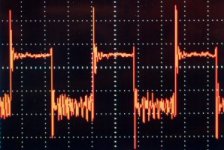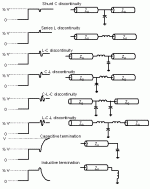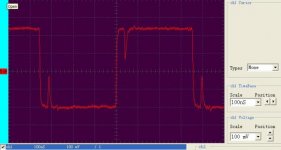Well I've used DIY (soldered coax) RCAs at base-band video for longish runs 100' with no perceptible loss in quality. S/PDIF bandwidth is 48Kb/s or about 200KHz @20 to 30dB RT loss) is trivial to compared to video applications BW 4-6MHz. The problem is that there are no specs for generic commercial audio audio cables. So buyer beware. One non DIY way to insure good quality cables is to use RCA - Fconn adapters and 75 ohm cables using RG6 coax crimped to male Fconn's. see similar to link here
bit erros won't occur; It is the jitter that makes audible differences
best
But can't jitter errors be re-clocked out with PLLs?
G²
I'm on the side that thinks that the RCA connector mis-match is insignificant in SPDIF Digital Audio. Heck, it's insignificant in any likely use of an RCA co-ax. It's also no greater than the mis-match inside the chassis. Mis-match factors are: Frequency, impedance difference and length of error.
SPDIF is very robust and for short lengths (say 2 meters) you could use a speaker wire. (although interference might be a problem). If your equipment is affected by SPDIF cables get better designed equipment.
SPDIF is very robust and for short lengths (say 2 meters) you could use a speaker wire. (although interference might be a problem). If your equipment is affected by SPDIF cables get better designed equipment.
SPDIF is very robust and for short lengths (say 2 meters) you could use a speaker wire. (although interference might be a problem). If your equipment is affected by SPDIF cables get better designed equipment.
In terms of data, SPDIF indeed is very robust. In terms of jitter it is the most lousy audio interface I've ever seen (apart from USB).
Making receivers with clock recovery circuits that are fully independent of incoming SPDIF is not an easy task.
best
In terms of data, SPDIF indeed is very robust. In terms of jitter it is the most lousy audio interface I've ever seen (apart from USB).
Making receivers with clock recovery circuits that are fully independent of incoming SPDIF is not an easy task.
best
Seems to me it should be on a par with a video Time Base Corrector, the job of which is to remove jitter from the signal. TBCs have been around for 50 years so it's not exactly something new.
G²
Seems to me it should be on a par with a video Time Base Corrector, the job of which is to remove jitter from the signal. TBCs have been around for 50 years so it's not exactly something new.
G²
What "is" new is that the level of jitter required for serious playback is VERY low, also for the very low frequency components of the jitter spectrum.
With our measurement equipment we are below 100fs now.
best
Measuring very low level jitter is one thing, hearing it is another!What "is" new is that the level of jitter required for serious playback is VERY low, also for the very low frequency components of the jitter spectrum.
With our measurement equipment we are below 100fs now.
best
Measuring very low level jitter is one thing, hearing it is another!
I am OK if you wish to stay ignorant
best
I'm on the side that thinks that the RCA connector mis-match is insignificant in SPDIF Digital Audio.
You picked wrong side 😀
SPDIF is very robust and for short lengths (say 2 meters) you could use a speaker wire. (although interference might be a problem). If your equipment is affected by SPDIF cables get better designed equipment.
Yes, it is very robust and you can use almost any wire you want, even speaker wire 😕 But please be prepare to take the consequences, your signal will look something like that or even worse
One free hint: If you use speaker wire for S/PDIF, make it long. Much longer than 2 meters.
I support Guido's comments, he know what is doing
 Take a look on my avatar, with those big ears I can hear what he is talking about
Take a look on my avatar, with those big ears I can hear what he is talking aboutAttachments
Last edited:
I've got one question to all of you that are so concerned about the impedance of the RCA connector. Why do you need exactly 75 Ohms connector and what do you expect if not 75 but let's say 50 or 30 or 100 Ohms? What I mean is what would you measure in all the impedance cases I mentioned above and how this would impact the SPDIF data transfer.
S/PDIF is not audio signal, it is RF transmitter. Coaxial cables are not just audio interconnects, they are Transmission lines with Characteristic impedance .
If anything in not OK (wrong cable, wrong connector,..) reflections will occur. You will not have multiple signals, but you will see spikes up or down on original signal. Or you will limit bandwith.
Attachments
Last edited:
For the non-believers: just take the test and put a BNC T-connector on your S/PDIF and introduce an increasingly capacitive or inductive load on the receiving side, deliberately destroying the matching impedance and listen.
Did some SWR measurements on S/PDIF transmitters and receivers. It's enjoyable. Increasing the return loss to 25-30dB by proper matching made quite a difference.
And oh, short runs are even more sensitive than longer runs as a lot of attenuation will make the transmitting side happier. Now, go figure how to make insentive S/PDIF's
Did some SWR measurements on S/PDIF transmitters and receivers. It's enjoyable. Increasing the return loss to 25-30dB by proper matching made quite a difference.
And oh, short runs are even more sensitive than longer runs as a lot of attenuation will make the transmitting side happier. Now, go figure how to make insentive S/PDIF's
would you mind to share with us what is the necessary bandwith the SPDIF requires?Or you will limit bandwith.
I'm curious what was the impedance of your SWR meter???Did some SWR measurements on S/PDIF transmitters and receivers. It's enjoyable.
Last edited:
S/PDIF is not audio signal
very wrong assumption. If you wish to gain insight in SPDIF, explain yourself how:
- The DA conversion clock is reconstructed from SPDIF
- How clock jitter affects the audio waveform
best
You picked wrong side 😀
Yes, it is very robust and you can use almost any wire you want, even speaker wire 😕 But please be prepare to take the consequences
Is that waveform you showed the effect of using an RCA connector in a 50R SPDIF line (i.e., 50R characteristic impedance cable) with correct source and termination? If not, do you have such a waveform? Could you (or Guido) show the effect of an RCA connector on the analog output of a D/A as well, given an otherwise correct transmission path (i.e., 50R source, 50R cable, 50R termination)?
beauty_divine said:would you mind to share with us what is the necessary bandwith the SPDIF requires?
depends on your music material (44.1 kHz, 48 kHz,....) and what you want on RX side, square or sine wave 🙂
For sine wave is enough 3 Mhz and RCA connector, for square wave you need much much more bandwith and 75 Ohm BNC.
very wrong assumption. If you wish to gain insight in SPDIF, explain yourself how:
- The DA conversion clock is reconstructed from SPDIF
- How clock jitter affects the audio waveform
best
Yes, I should be more specific. English is not my native language.
It is audio signal, but it is not 20 Hz-20 kHz audio signal and should not be treated same way as 20Hz-20kHz audio signals.
What I mean is to know for 44,1 KHz and standard SPDIF what BW do you need? Is that Clear enough?depends on your music material (44.1 kHz, 48 kHz,....) and what you want on RX side, square or sine wave 🙂
For sine wave is enough 3 Mhz and RCA connector, for square wave you need much much more bandwith and 75 Ohm BNC.
What I mean is to know for 44,1 KHz and standard SPDIF what BW do you need? Is that Clear enough?
my target value is 50MHz
best
For the non-believers: just take the test and put a BNC T-connector on your S/PDIF and introduce an increasingly capacitive or inductive load on the receiving side, deliberately destroying the matching impedance and listen.
Did some SWR measurements on S/PDIF transmitters and receivers. It's enjoyable. Increasing the return loss to 25-30dB by proper matching made quite a difference.
And oh, short runs are even more sensitive than longer runs as a lot of attenuation will make the transmitting side happier. Now, go figure how to make insentive S/PDIF's
In addition: The higher the bandwidth of the driving source, the more reflections will be caused in case of irregularities in the characteristic impedance.
cheers,
- Status
- Not open for further replies.
- Home
- Source & Line
- Digital Source
- True 75ohm RCA Type Plug Possible?



